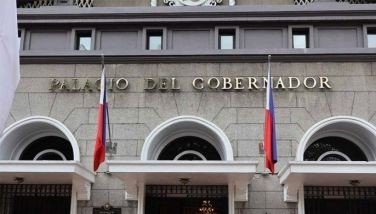EO issued making Lorenzo adviser for job generation

July 27, 2004 | 12:00am
Ten days after accepting Agriculture Secretary Luis Lorenzo Jr.’s resignation from the Cabinet, President Arroyo has named him her presidential adviser for jobs generation.
The President, in Executive Order 333 she issued last July 19, created the Office of the Presidential Adviser for Jobs Generation (OPAJG).
Under EO 333, a copy of which was obtained by The STAR yesterday, the President gave Lorenzo the mandate to "coordinate the effective and timely implementation of the government’s roadmap for jobs generation."
This roadmap consists of the government’s commitment to create up to 10 million jobs and develop up to two million hectares of agribusiness land within the next six years.
The President said job creation is part of her 10-point program of government she promised to pursue during her term.
"In order for all concerned offices and agencies of the government to have unity of purpose and consistency in action to achieve these objectives, there is an urgent need to establish an office which shall coordinate, on a full-time basis, the effective and timely implementation of the government’s commitments as outlined," she cited in EO 333.
Prior to appointing Lorenzo as agriculture secretary, Mrs. Arroyo designated him as her presidential adviser for one million jobs. He was tasked to monitor her administration’s implementation of the agricultural modernization program, which contains the bulk of the one million jobs she promised to create when she took office in January 2001.
The President tasked Lorenzo, in his capacity as OPAJG head, to advise her on programs, policies and projects that will help her administration realize her promise to create six million to 10 million new jobs in the next six years.
In order to perform his new duties, she authorized Lorenzo to serve as ex officio chairman of the governing boards of the state-run Land Bank of the Philippines (LBP) and the Quedan and Rural Credit Guarantee Corp. (Quedancor).
Mrs. Arroyo said the provisions in EO 322 and 323, which she issued last July 5, that are inconsistent with that of EO 333 have been amended.
EO 322 provides that the President can appoint a new ex officio chairman of the LBP’s governing board, a position previously held by the finance secretary. EO 323 made the agriculture secretary an ex officio member of Quedancor’s governing board and the President can appoint an ex officio chairman.
When Mrs. Arroyo accepted Lorenzo’s resignation last July 9, she appointed him as the ex officio chairman of the governing boards of both LBP and Quedancor.
The President ordered the funds for the operational and administrative expenses of OPAJG and its secretariat "to be sourced from available funds of the LBP and Quedancor."
She also authorized Lorenzo to get his personnel — subject to existing civil service laws — from Quedancor, LBP and other agencies involved in job generation.
Mrs. Arroyo named Arthur Yap to take over Lorenzo’s former post. Yap was previously agriculture undersecretary and concurrent administrator of the National Food Authority.
Meanwhile, the President abolished the Information Technology and Electronic Commerce Council (ITTEC) and transferred its budget, assets, personnel, programs and projects to the Commission on Information and Communications Technology (CICT).
"It is desirable to centralize all ICT and ICT-related programs and projects, functions and initiatives in one government agency," Mrs. Arroyo cited in EO 334, which she issued last July 20.
The ITTEC was created in 2000 by then President Joseph Estrada to achieve the vision of an electronically enabled Philippines. He signed EO 264 merging the National Information Technology Council (NITC) and the Electronic Commerce Promotion Council (ECPC) to form ITECC.
When Mrs. Arroyo took over in January of 2001, she transferred the chairmanship of ITECC to the President by signing EO 18, amending EO 264. This move allowed her to oversee the direction of ITECC and ICT development in the country. It also expanded, enhanced, and accelerated ITECC’s policy-implementation capabilities and decision-making processes.
In abolishing the ITTEC, the President cited she subsequently issued EO 269, dated Jan. 12, 2004, which created the CICT pending the approval of a measure she submitted to the 12th Congress to create the Department of Information and Technology.
The previous Congress adjourned without acting on this Palace-certified bill.
The President, in Executive Order 333 she issued last July 19, created the Office of the Presidential Adviser for Jobs Generation (OPAJG).
Under EO 333, a copy of which was obtained by The STAR yesterday, the President gave Lorenzo the mandate to "coordinate the effective and timely implementation of the government’s roadmap for jobs generation."
This roadmap consists of the government’s commitment to create up to 10 million jobs and develop up to two million hectares of agribusiness land within the next six years.
The President said job creation is part of her 10-point program of government she promised to pursue during her term.
"In order for all concerned offices and agencies of the government to have unity of purpose and consistency in action to achieve these objectives, there is an urgent need to establish an office which shall coordinate, on a full-time basis, the effective and timely implementation of the government’s commitments as outlined," she cited in EO 333.
Prior to appointing Lorenzo as agriculture secretary, Mrs. Arroyo designated him as her presidential adviser for one million jobs. He was tasked to monitor her administration’s implementation of the agricultural modernization program, which contains the bulk of the one million jobs she promised to create when she took office in January 2001.
The President tasked Lorenzo, in his capacity as OPAJG head, to advise her on programs, policies and projects that will help her administration realize her promise to create six million to 10 million new jobs in the next six years.
In order to perform his new duties, she authorized Lorenzo to serve as ex officio chairman of the governing boards of the state-run Land Bank of the Philippines (LBP) and the Quedan and Rural Credit Guarantee Corp. (Quedancor).
Mrs. Arroyo said the provisions in EO 322 and 323, which she issued last July 5, that are inconsistent with that of EO 333 have been amended.
EO 322 provides that the President can appoint a new ex officio chairman of the LBP’s governing board, a position previously held by the finance secretary. EO 323 made the agriculture secretary an ex officio member of Quedancor’s governing board and the President can appoint an ex officio chairman.
When Mrs. Arroyo accepted Lorenzo’s resignation last July 9, she appointed him as the ex officio chairman of the governing boards of both LBP and Quedancor.
The President ordered the funds for the operational and administrative expenses of OPAJG and its secretariat "to be sourced from available funds of the LBP and Quedancor."
She also authorized Lorenzo to get his personnel — subject to existing civil service laws — from Quedancor, LBP and other agencies involved in job generation.
Mrs. Arroyo named Arthur Yap to take over Lorenzo’s former post. Yap was previously agriculture undersecretary and concurrent administrator of the National Food Authority.
Meanwhile, the President abolished the Information Technology and Electronic Commerce Council (ITTEC) and transferred its budget, assets, personnel, programs and projects to the Commission on Information and Communications Technology (CICT).
"It is desirable to centralize all ICT and ICT-related programs and projects, functions and initiatives in one government agency," Mrs. Arroyo cited in EO 334, which she issued last July 20.
The ITTEC was created in 2000 by then President Joseph Estrada to achieve the vision of an electronically enabled Philippines. He signed EO 264 merging the National Information Technology Council (NITC) and the Electronic Commerce Promotion Council (ECPC) to form ITECC.
When Mrs. Arroyo took over in January of 2001, she transferred the chairmanship of ITECC to the President by signing EO 18, amending EO 264. This move allowed her to oversee the direction of ITECC and ICT development in the country. It also expanded, enhanced, and accelerated ITECC’s policy-implementation capabilities and decision-making processes.
In abolishing the ITTEC, the President cited she subsequently issued EO 269, dated Jan. 12, 2004, which created the CICT pending the approval of a measure she submitted to the 12th Congress to create the Department of Information and Technology.
The previous Congress adjourned without acting on this Palace-certified bill.
BrandSpace Articles
<
>
- Latest
- Trending
Trending
Latest
Trending
Latest
Recommended






























